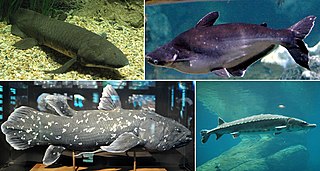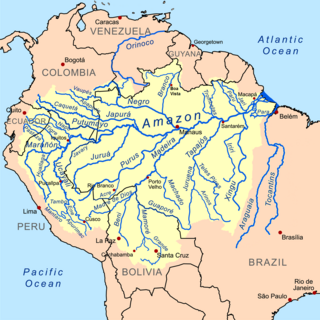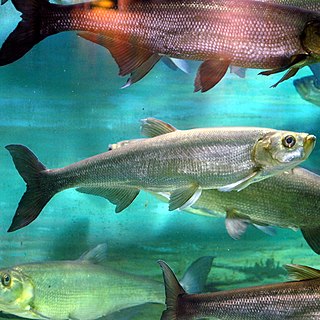
Osteichthyes, popularly referred to as the bony fish, is a diverse taxonomic group of fish that have skeletons primarily composed of bone tissue. They can be contrasted with the Chondrichthyes, which have skeletons primarily composed of cartilage. The vast majority of fish are members of Osteichthyes, which is an extremely diverse and abundant group consisting of 45 orders, and over 435 families and 28,000 species. It is the largest class of vertebrates in existence today. The group Osteichthyes is divided into the ray-finned fish (Actinopterygii) and lobe-finned fish (Sarcopterygii). The oldest known fossils of bony fish are about 420 million years old, which are also transitional fossils, showing a tooth pattern that is in between the tooth rows of sharks and bony fishes.

Fish sauce is a liquid condiment made from fish or krill that have been coated in salt and fermented for up to two years. It is widely used as a staple seasoning in East and Southeast Asian cuisine.

Carp are various species of oily freshwater fish from the family Cyprinidae, a very large group of fish native to Europe and Asia. While carp is consumed in many parts of the world, they are generally considered an invasive species in parts of Africa, Australia and most of the United States.

Tilapia is the common name for nearly a hundred species of cichlid fish from the coelotilapine, coptodonine, heterotilapine, oreochromine, pelmatolapiine, and tilapiine tribes, with the economically most important species placed in the Coptodonini and Oreochromini. Tilapia are mainly freshwater fish inhabiting shallow streams, ponds, rivers, and lakes, and less commonly found living in brackish water. Historically, they have been of major importance in artisanal fishing in Africa, and they are of increasing importance in aquaculture and aquaponics. Tilapia can become a problematic invasive species in new warm-water habitats such as Australia, whether deliberately or accidentally introduced, but generally not in temperate climates due to their inability to survive in cold water.

Fish farming or pisciculture involves raising fish commercially in tanks or enclosures such as fish ponds, usually for food. It is the principal form of aquaculture, while other methods may fall under mariculture. A facility that releases juvenile fish into the wild for recreational fishing or to supplement a species' natural numbers is generally referred to as a fish hatchery. Worldwide, the most important fish species produced in fish farming are carp, tilapia, salmon, and catfish.

The Amazon Basin is the part of South America drained by the Amazon River and its tributaries. The Amazon drainage basin covers an area of about 6,300,000 km2 (2,400,000 sq mi), or about 35.5 percent of the South American continent. It is located in the countries of Bolivia, Brazil, Colombia, Ecuador, French Guiana (France), Guyana, Peru, Suriname, and Venezuela.

Swedish Fish is a fish-shaped, chewy candy originally developed by Swedish candy producer Malaco in the late 1950s for the U.S. market. The wrapper calls them "a fat free food", and they are gluten-free. The sweet fish-shaped treats are marketed in different colors and flavors.

Pisces (♓︎) is the twelfth astrological sign in the Zodiac. It is a negative, mutable sign. It spans 330° to 360° of celestial longitude. Under the tropical zodiac, the sun transits this area between February 19 and March 20. In sidereal astrology, the Sun currently transits the constellation of Pisces from approximately March 12 to April 18. In classical interpretations, the symbol of the fish is derived from the ichthyocentaurs, who aided Aphrodite when she was born from the sea.

Fish head curry is a dish in Indonesian, Malaysian and Singaporean cuisines with mixed Indian and Chinese origins. The head of a red snapper is stewed in a Kerala-style curry with assorted vegetables such as okra and eggplants. It is usually served with either rice or bread, or as a shared dish.

Fish are gill-bearing aquatic craniate animals that lack limbs with digits. They form a sister group to the tunicates, together forming the olfactores. Included in this definition are the living hagfish, lampreys, and cartilaginous and bony fish as well as various extinct related groups. Around 99% of living fish species are ray-finned fish, belonging to the class Actinopterygii, with over 95% belonging to the teleost subgrouping.

The Cultrinae are one of at least 13 subfamilies of cyprinid fish. It contains ten genera.

Pescetarianism is the practice of using seafood as the only source of meat in a diet that is otherwise vegetarian.

Toxabramis is a genus of cyprinid fish found in eastern Asia. There are currently seven species in this genus.
Toxabramis hoffmanni is a species of ray-finned fish in the genus Toxabramis. It is found in Guangxi, China.
Toxabramis hotayensis is a species of ray-finned fish in the genus Toxabramis. It is found in Vietnam.
Toxabramis houdemeri is a species of ray-finned fish in the genus Toxabramis. It is found in China and Vietnam.
Toxabramis maensis is a species of ray-finned fish in the genus Toxabramis. It is found in Vietnam.
Toxabramis nhatleensis is a species of ray-finned fish in the genus Toxabramis. It is found in Vietnam.
Toxabramis swinhonis is a species of ray-finned fish in the genus Toxabramis. It is found in the Yangtze, Yellow, and other rivers in China.













